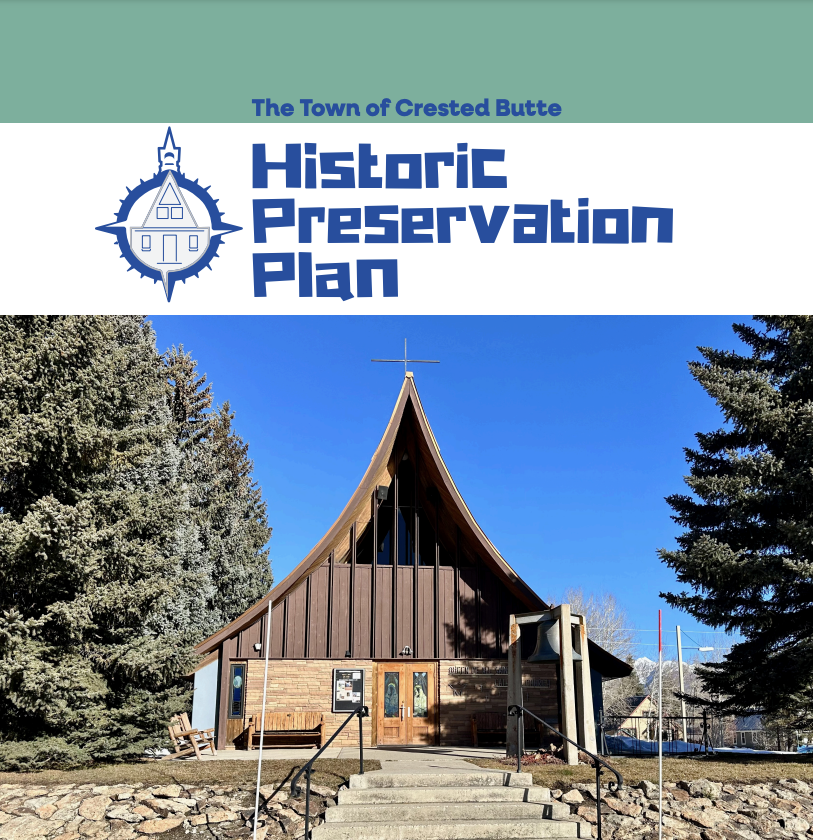Historic Preservation Plan
Maintaining Crested Butte’s authenticity and unique character.
The Town of Crested Butte completed its Comprehensive Plan, the Community Compass, in 2023 and in December of 2024 adopted the first Historic Preservation Plan (“HPP”).
The Town has had preservation policies and regulations since 1970. The current regulations protect buildings built between 1880-1952, known as the Coal Mining Period of Significance ("POS") and regulate the architectural style of every building in Town.
Guided by the goal to “retain the unique character and traditions of Crested Butte,” the HPP is intended to establish how the Town can ensure that its architectural identity reflects Crested Butte’s deep sense of community and its evolution over time, not just 1880 to 1952.
The preservation strategy identified in the HPP includes the following:
Update Design Standards to be more clear, concise and graphically oriented.
Reduction of the local historic district from townwide coverage to a buffer around the National Historic District.
Revisions to the zoning code relating to demolition, provision of incentives and potential for administrative level review.
Adoption of new POS relating to the Early Recreation/ Ski Era (1961-1984).
During the research and development of the HPP, a consultant hired by the Town of Crested Butte, along with staff, conducted windshield surveys of all buildings constructed between 1953 and 1994 to assess the feasibility of establishing a new POS. Through this work and the subsequent adoption of the HPP, it was determined that some buildings from this period hold historical significance.
The Town received a Certified Local Government grant to conduct this work. The goal of this survey work is to catalogue the architecture and provide the Town with recommendations for which properties would contribute to a new Early Recreation/Ski Era district. In addition to looking at age, integrity, and potential architectural significance, this process will consider features such as floor area, massing, exterior details, secondary structures, and the extent of alterations. Notes and photographs will be taken at each property, from the Town’s rights of way.
Based on the findings from this survey work, staff will schedule a public meeting, likely in the first or second quarter of 2026, to present the information and outline the next steps. Then, the HPP strategy will be implemented and codified as the Town updates its Zoning Code and Design Standards and Guidelines starting later in the year. Check out the action plan in the plan document to learn more about each action item. Check back here and stay tuned for updates in the Town's e-blast for 2025 implementation projects and how you can participate.
The Plan...
Rooted in the Community Compass decision-making framework, the HPP builds on lessons from Crested Butte’s past, addresses contemporary preservation challenges, and establishes clear measures of success for the Town’s future. The HPP outlines a strategy to continue honoring Crested Butte’s mining heritage, while identifying its transformation into a ski and recreation-based community. The strategy includes:
Local Designation
- Celebrate and preserve buildings from Crested Butte’s “Early Recreation Era” by adding a New Period of Significance (POS) between 1961 to 1984.
- Enhance the visibility and significance of Crested Butte’s historic buildings by defining distinct boundaries and buffers for each POS, rather than encompassing the entire Town.
Zoning Regulations
- Mitigate the risk of losing historic buildings through strengthening the Town's demolition regulations.
Design Standards and Guidelines
- Outside of the Historic POSs, encourage architectural flexibility and variety while maintaining Crested Butte’s mass, scale, form and history of modest, affordable design.
- Encourage more variety and creativity in materials that build on Crested Butte’s architectural vernacular and promote environmental sustainability and resiliency.
Incentives
- Provide incentives to support property owners in the upkeep and maintenance of historic buildings and sheds.
- Reward projects that adhere to the Design Standards and Guidelines by offering streamlined processes, including administrative review.


